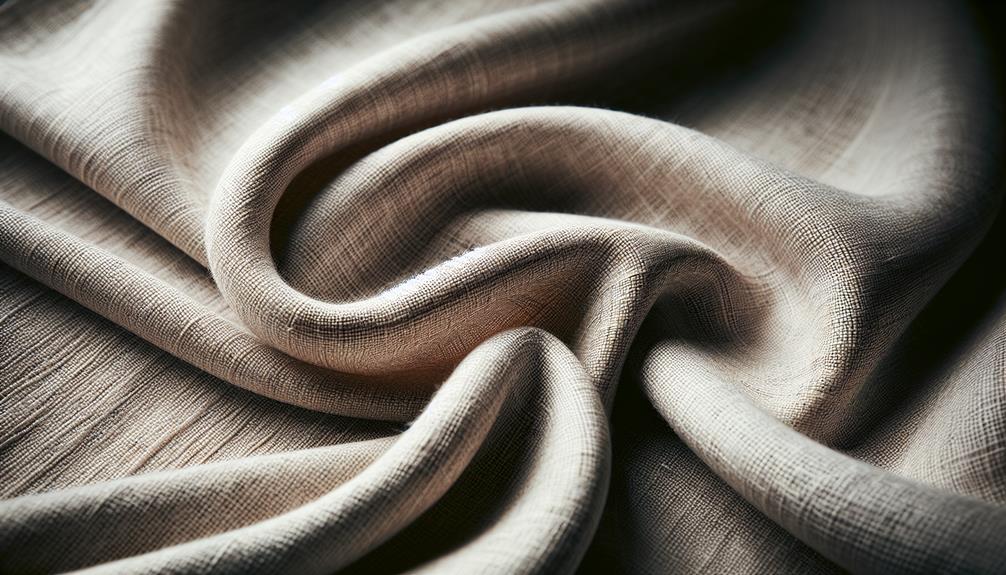To identify linen fabric, look for its natural creases which show authenticity and quality. Genuine linen has low elasticity, helping it maintain shape and durability. It softens more with every wash, gaining a gentle feel. Authentic linen has distinct creases, unique textures, and improves over time. It's highly absorbent, perfect for staying cool in hot weather. Real linen feels cool to the touch, stands out from other materials. Its characteristics include elegant creases and a soft silhouette. Linen ages beautifully, getting softer and more luxurious. Check the natural creases first; they reveal a lot about the fabric.
Table of Contents
Key Takeaways
- Authentic linen has distinctive natural creases.
- Genuine linen exhibits low elasticity.
- Linen softens with washing, increasing in comfort.
- High absorption rate sets linen apart.
- Real linen feels cool to the touch, unique feature.
Natural Creases in Linen Fabric
When inspecting linen fabric, one can easily identify authentic flax linen by the presence of its distinctive natural creases. These creases are a result of linen's low elasticity, creating a natural texture that sets it apart from fake alternatives. The beauty of real linen lies in these soft creases, which give the fabric a relaxed and casual appearance. Unlike synthetic materials, genuine linen maintains its folded shapes and creases, enhancing its aesthetic appeal and showcasing its organic characteristics.
The natural creases in linen not only add to its visual charm but also contribute to its overall feel. When touching real flax linen, you can appreciate the gentle texture created by these creases, providing a luxurious yet understated quality. This unique feature makes linen a favorite choice for those who appreciate fine textiles with a natural, effortless elegance. So, next time you're examining linen fabric, pay attention to these natural creases as they're a clear indicator of the authenticity and quality of the material.
Low Elasticity of Genuine Linen
Discussing the low elasticity of genuine linen reveals a key characteristic that distinguishes it from other fabrics. Genuine linen fabric has low elasticity, meaning it doesn't stretch much when pulled. This unique feature allows linen to maintain its shape exceptionally well and resist deformation over time. Unlike fabrics such as cotton, which have higher elasticity and can stretch more, linen's low elasticity contributes greatly to its durability and long-lasting nature.
When trying to determine if a fabric is truly linen, testing for low elasticity can be an important step in confirming its authenticity. The lack of significant stretch in linen isn't a flaw but rather a strength, as it enhances the fabric's ability to retain its form and structure, making it a preferred choice for items where shape retention is essential. Understanding and appreciating the low elasticity of linen is key to recognizing and valuing this exceptional fabric.
Softening With Each Wash
I love how linen fabric gets softer with every wash. It's like a little luxury that keeps getting better over time.
The more I wash my linen pieces, the comfier and more inviting they become, making them a joy to use. Softened linen just feels so gentle and cozy, giving a lovely touch to any linen product.
Increased Softness Over Time
As linen fabric undergoes multiple washes, it gradually softens and gains a more luxurious texture, providing increased comfort with each use.
The initial roughness that may be present in new linen diminishes over time, resulting in a smoother and more pleasant feel against the skin. This natural softening process is one of the distinctive characteristics of linen, making it a sought-after fabric for those who appreciate comfort and quality.
Authentic linen products only get better with age, as the fibers break down further with each wash, enhancing the overall softness and luxuriousness of the material.
Washing Enhances Comfort
Enhancing the comfort of linen fabric occurs gradually with each wash, resulting in a smoother and more luxurious feel over time. When washing linen, the process helps break down the rough fibers, allowing the natural fibers to become more supple and pleasant.
With each wash, the fabric softens further, becoming increasingly comfortable. The more you care for your linen through washing, the softer and more enjoyable it becomes.
Regular washing not only enhances the comfort of linen but also improves its overall quality, making it a durable and long-lasting choice. By incorporating washing into your linen care routine, you can experience the full potential of this exquisite fabric and enjoy its luxurious feel with every use.
Linen Fabrics Gentle Feel
Moving smoothly from the advantages of regular washing, the delicate feel of linen fabrics evolves with each wash, gradually softening to provide a luxurious and comfortable experience over time. The texture of linen is unique in how it becomes smoother with each use, setting it apart from other materials. This natural softening process is why linen is favored for bedding and clothing, as it offers a refined and gentle sensation against the skin. Below is a table highlighting the progression of linen fabric softness with successive washes:
| Wash Number | Fabric Texture |
|---|---|
| 1 | Slightly rough |
| 5 | Beginning to soften |
| 10 | Noticeably smoother |
Distinct Appearance of Authentic Linen
When identifying authentic linen, one key indicator lies in its distinct natural creases and wrinkles resulting from its low elasticity. These unique characteristics give linen its distinct texture, setting it apart from other fabrics. Authentic linen maintains its folded shapes and creases, creating a soft silhouette that adds to its charm. As real linen is used and washed, it tends to soften and improve, enhancing its natural appearance and feel.
In contrast, fake linen may resist wrinkles and lack the natural texture of authentic linen. By paying attention to the distinct appearance and feel of linen, one can easily differentiate between genuine linen and imitations. The ability to recognize these features is essential in identifying the authenticity of linen fabric. So, next time you come across linen, remember to look for those natural creases and wrinkles that make it truly unique.
High Absorption Rate of Linen
I've always been amazed by how linen fabric has this incredible ability to absorb moisture efficiently.
When I run a quick test, it's evident that linen outperforms cotton in this aspect, making it a standout choice for hot weather.
The high absorption rate of linen truly sets it apart and proves its practicality for staying cool in the summer.
Absorbency of Linen
Linen fabric's exceptional absorbency sets it apart from other materials, making it a top choice for staying cool in warm weather. Its high absorbency rate allows for quick moisture absorption, keeping you comfortable on hot days. Take a look at the table below to see how linen compares to other fabrics regarding absorbency:
| Fabric | Absorbency Level |
|---|---|
| Linen | High |
| Cotton | Moderate |
| Silk | Low |
This table clearly shows that linen outshines cotton and silk when it comes to absorbing moisture. Embrace the cool sensation of linen during the heat with its superior absorbency properties.
Linens Moisture Absorption
Coming from our discussion on the exceptional absorbency of linen fabric, let's now explore the high absorption rate of linen in detail.
Linen fabric can absorb up to 20% of its weight in moisture, showcasing its impressive absorption capabilities. This feature not only helps in regulating body temperature but also makes linen ideal for summer wear due to its ability to wick away sweat and moisture efficiently.
Compared to cotton, linen absorbs moisture more quickly, a fact easily verified through the wet finger test. Linen's high hygroscopicity guarantees a comfortable sleep experience, especially in hot weather conditions.
Testing the absorption rate can be a useful method to distinguish linen fabric from other materials like cotton, highlighting the unique properties of this natural textile.
Linen Fabrics Absorption
With its remarkable ability to absorb up to 20% of its weight in moisture, linen fabric stands out for its exceptional absorption properties. This high absorption rate makes linen an excellent choice for clothing and home textiles, especially in warm climates.
The fabric's quick absorption of moisture helps in keeping the body cool and dry, making it ideal for summer wear. When compared to cotton, linen's absorption rate is superior, showcasing its efficiency in quickly soaking up liquids. Whether used in bedding to provide a comfortable sleep experience during hot nights or in garments to wick away sweat, linen's absorption capabilities are truly impressive.
Next time you need a fabric that excels in absorption, consider the versatile and absorbent linen.
Cool Touch as Indicator of Authenticity
Sensing the invigorating coolness of genuine linen fabric serves as a reliable indicator of its authenticity. When you touch real linen, you'll immediately notice its cool feel, which is a result of the fabric's exceptional moisture-wicking properties. This cool sensation is a distinctive characteristic of linen and sets it apart from other materials.
The natural fibers and unique structure of linen work together to maintain this revitalizing cool touch, making it a dependable way to differentiate real linen from imitations. By simply feeling the fabric and recognizing its coolness, you can start to identify whether it's authentic linen or not.
Testing the cool touch of linen fabric is a practical and effective method in determining its genuineness, allowing you to confidently assess the quality of the material. Remember, the cool touch of linen isn't just a pleasant sensation but a valuable clue to its authenticity.
Characteristics of Real Flax Linen
Real flax linen showcases its authenticity through natural, beautiful creases that reflect its low elasticity. These creases are a result of the fibers derived from the flax plants, which don't stretch or deform easily. When examining linen, the presence of these creases is a key indicator of its genuineness. Genuine flax linen holds onto these folded shapes and creases, contributing to its soft and elegant silhouette.
In contrast, fake linen lacks this characteristic and may appear more rigid or springy due to its higher elasticity. One way to differentiate between real flax linen and imitations is by observing how the fabric naturally wrinkles and holds those wrinkles. Authentic linen will have a more relaxed and natural look, whereas fake linen might resist wrinkles and appear overly smooth or perfectly ironed.
Aging Gracefully and Getting Softer
As linen ages, it gracefully becomes softer with each wash, enhancing its natural comfort and luxurious appeal. Authentic flax linen, known for its quality, undergoes a remarkable transformation over time. Initially rough to the touch, this fabric softens gradually with washing and use.
The rough texture that might've been present in the beginning fades away, giving way to a beautifully comfortable feel against the skin. The softness of real flax linen only improves with age, offering an increasingly luxurious experience every time it's used and washed.
This unique quality sets linen apart, as it embraces a natural evolution towards greater softness and comfort. Investing in quality linen products means investing in a future of heightened softness and indulgent comfort, making each piece a joy to own and use.
Frequently Asked Questions
How Do You Know if Something Is 100% Linen?
To know if something is 100% linen, I look for natural colors like pale yellowish-gray, observe its wrinkle-prone nature and low stretchiness. Authentic linen quickly absorbs liquids, is durable, and has a rough texture that smoothes with time.
How Is Linen Identified?
Identifying linen involves checking for natural colors, wrinkles, low elasticity, durability, absorbency, slubs, and a rough texture that smooths over time. These characteristics help me determine if the fabric is genuine linen, ensuring quality and authenticity.
What Are the 5 Characteristics of Linen Fabric?
Linen fabric boasts absorbency, hypoallergenic properties, antibacterial nature, unique texture, and luster. It develops natural wrinkles while staying durable and resistant to wear. Over time, it smooths out its rough texture.
How Can You Tell the Difference Between Linen and Cotton Fabric?
When telling the difference between linen and cotton fabric, focus on how they absorb water and their cooling properties. Linen absorbs water faster and feels cooler due to its smoother texture. These characteristics set linen apart.
- Does Linen Keep You Cool at Night? - April 9, 2024
- Is Linen Cool for Sleeping? - April 9, 2024
- Is Linen Sun Proof? - April 9, 2024







